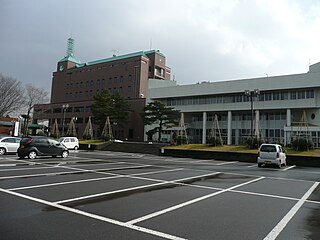
Itoigawa is a city located in Niigata Prefecture, Japan. As of 1 July 2019, the city had an estimated population of 41,513, and a population density of 55.6 persons per km². The total area of the city is 746.24 square kilometres (288.12 sq mi).

Myōkō is a city located in Niigata Prefecture, Japan. As of 1 July 2019, the city had an estimated population of 31,226 in 12,390 households, and a population density of 70.1 persons per km². The total area are of the city was 445.63 square kilometres (172.06 sq mi). Myōkō is a member of the World Health Organization’s Alliance for Healthy Cities (AFHC).

Otari is a village located in Nagano Prefecture, Japan. As of 30 November 2018, the village had an estimated population of 2,914 in 1251 households, and a population density of 11 persons per km². The total area of the village is 267.91 square kilometres (103.44 sq mi).
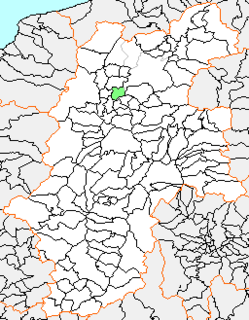
Ōoka was a village located in Sarashina District, Nagano Prefecture, Japan.
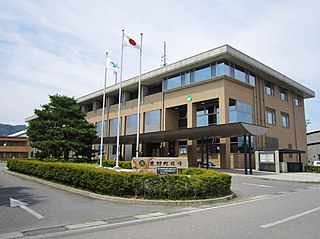
Toyono was a town located in Kamiminochi District, Nagano Prefecture, Japan.

Togakushi was a village located in the mountainous Kamiminochi District, Nagano Prefecture, Japan. Part of Togakushi is located in Myōkō-Togakushi Renzan National Park. One of Japan's largest campgrounds is found here.
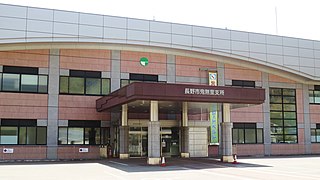
Kinasa was a village located in Kamiminochi District, Nagano Prefecture, Japan.
Kamiminochi is a district located in Nagano Prefecture, Japan.
Myōkōkōgen was a town in Nakakubiki District, Niigata Prefecture, Japan]
Kuzuryū, or Kuzuryūshin is a deity that appears in folklore and legends of various parts of Japan, including, for example, Hakone (Kanagawa), Nagano Prefecture and Fukui Prefecture. In many cases, the Kuzuryū is associated with water.

Jōshin'etsu-kōgen National Park is a national park in the Chūbu region of the main island of Honshū, Japan formed around several active and dormant volcanoes. It spans the mountainous areas of Gunma, Nagano, and Niigata prefectures. The name refers to the two mountain ranges that make up the park. It was divided into two separate areas: the Southern Niigata/North Nagano Area and the East Nagano Area.

The Togakushi Shrine is a Shinto shrine in Togakushi, Nagano (city), Nagano Prefecture, Japan. The shrine is at the base of Mount Togakushi in Myōkō-Togakushi Renzan National Park. Togakushi Shrine consists of five shrines, known as the lower, middle, and upper shrine area, each area about 2 km apart.

Nagano is the capital and largest city of Nagano Prefecture, located in the Nagano Basin in the central Chūbu region of Japan. Nagano is categorized as a core city of Japan. Nagano City is the highest prefectural capital in Japan, with an altitude of 371.4 meters (1,219 ft). The city is surrounded by mountains, near the confluence of the Chikuma River - the longest and widest river in Japan - and the Sai River. The total area of the city is 834.81 square kilometres (322.32 sq mi). As of 1 June 2019, the city had an estimated population of 370,632 in 160,625 households, and a population density of 444 persons per km² The total area of the city is 834.81 square kilometres (322.32 sq mi).

Asahi Broadcasting Nagano Co.,Ltd., also known as abn, is a Japanese broadcast network affiliated with the ANN. Their headquarters are located in Nagano Prefecture.

Mount Iizuna, also known as Mount Izuna, is a mountain located ten kilometers north-northwest of the heart of Nagano, Nagano Prefecture, Japan. Together with Mount Reisenji 1875.0 m, Mount Menō 1748 m, and others, it forms the Iizuna range. It has an elevation of 1,917 metres. It is one of the "Five Mountains of Northern Shinshu" (北信五岳) that includes: Mount Myōkō (妙高山), Mount Kurohime (黒姫山), Mount Togakushi (戸隠山) and Mount Madarao (斑尾山).

A kijo is an oni woman from Japanese legends.
Ame-no-tajikarao (アメノタジカラオ) is a Japanese deity (kami) who appears in Japanese mythology. Ame-no-tajikarao is written as 天手力男神 in Kojiki, and 天手力雄神 in Nihon Shoki.
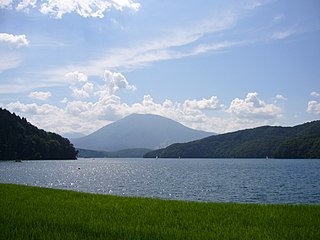
Myōkō-Togakushi Renzan National Park is a national park in Niigata Prefecture and Nagano Prefecture, Japan. Established in 2015, and formerly part of Jōshin'etsu-kōgen National Park, the park comprises an area of 39,772 ha in the municipalities of Itoigawa and Myōkō in Niigata Prefecture and Iizuna, Nagano, Otari, and Shinano in Nagano Prefecture. Prominent features of the park include Mount Myōkō, Mount Togakushi (戸隠山), Mount Amakazari (雨飾山), Mount Iizuna, Mount Kurohime (黒姫山), Niigata-Yake-Yama, and Lake Nojiri.

The Jōshin'etsu region is a region on the main Japanese island of Honshu, comprising parts of Gunma, Nagano, and Niigata Prefectures. It is a mountainous area with a large national park and numerous hot springs and ski resorts. It has long been a transportation corridor between the Kantō plain and coastal areas on the Japan Sea side of the island.

The Kitano Museum of Art, which opened in 1968 as the first private art museum in Nagano Prefecture, is today run by a public interest incorporated foundation, in the Wakaho district, in the southeastern section of Nagano in Nagano Prefecture. The museum is located next to the Yushimatenmangu Shrine, a branch of Yushima Tenman-gū which was founded in 458 in Bunkyō in Tokyo. The entrance to the museum is through the Yushimatenmangu Shrine. The museum includes a Japanese garden by Mirei Shigemori, a notable 20th century modern landscape architect, that was completed in 1965.















